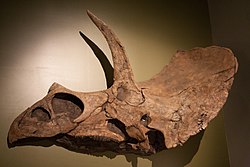Eotriceratops
|
Eotriceratops Temporal range: Late Cretaceous, 68–67.6 Ma |
|
|---|---|
 |
|
| Reconstructed skull | |
| Scientific classification | |
| Kingdom: | Animalia |
| Phylum: | Chordata |
| Class: | Reptilia |
| Clade: | Dinosauria |
| Order: | †Ornithischia |
| Family: | †Ceratopsidae |
| Subfamily: | †Chasmosaurinae |
| Tribe: | †Triceratopsini |
| Genus: |
†Eotriceratops Wu et al., 2007 |
| Species: | †E. xerinsularis |
| Binomial name | |
|
Eotriceratops xerinsularis Wu et al., 2007 |
|
| Synonyms | |
|
|
Eotriceratops (meaning "dawn three-horned face") is a genus of herbivorous ceratopsian dinosaurs which lived in the area of North America during the late Cretaceous period. The only named species is Eotriceratops xerinsularis.
In early August 1910, Barnum Brown during an American Museum of Natural History expedition discovered a large dinosaur skeleton in the Dry Island site, on the west bank of the Red Deer River in southern Alberta, Canada. Brown however, neglected this find as he was more interested in the many Albertosaurus specimens present in the location. Unaware of Brown's prospect, in 2001 a team of the Royal Tyrrell Museum of Palaeontology and the Canadian Museum of Nature mounted an expedition to the Dry Island. The expedition's cook, Glen Guthrie, that year by accident rediscovered the skeleton.
Eotriceratops was named and described by Xiao-Chun Wu, Donald B. Brinkman, David A. Eberth and Dennis R. Braman in 2007. The type species is Eotriceratops xerinsularis. The generic name combines a Greek ἠώς, èos, "dawn", with the name of the genus Triceratops, in reference to an older age relative to that form. The specific name xerinsularis, means "of the dry island", from Greek ξηρός, xèros, "dry", and Latin insula, "island" and is a reference to the Dry Island Buffalo Jump Provincial Park where its remains were found.
The holotype specimen, RTMP 2002.57.5, has been found in a layer of the uppermost Horseshoe Canyon Formation, dated to the early Maastrichtian, about 67.6 million years ago. It consist of a partial skeleton with skull, lacking the lower jaws. It contains a partial skull including parts of the frill sides, large horns above the eyes, and a small horn above the nose, similar to the closely related Triceratops. At least seven neck and five back vertebrae, as well as several ribs and ossified tendons, were also recovered. The bones were largely found disarticulated. Because the specimen was found in weakly bedded shale, many of the bones were badly crushed.
...
Wikipedia
